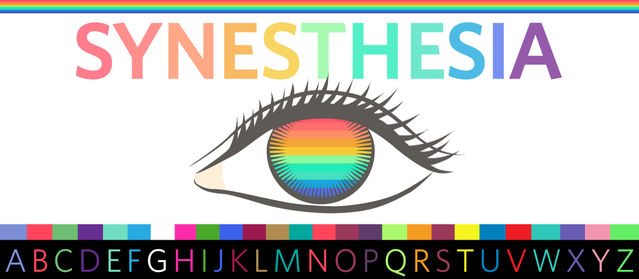Synesthesia
Garbage Smells Green and Gunshots Are Rainbows
Some people hear colors and see sounds, a phenomenon called synesthesia.
Posted September 15, 2017

The minds of individuals are like parallel universes, forever inaccessible to one another. Never do we truly see through the eyes of another person. It is common for us to wonder if other people experience the world in the same way we do. Is your green my red? Is my yellow your blue?
While we can never directly answer these questions, we know that some people report a very different consciousness of the outside world than what is commonly experienced. This different conscious experience is known as synesthesia, as it is a seamless blending of sound with color, tastes with words, color with letters, or even space with numbers. While it is normal for individuals to integrate different senses through what is known as multimodal integration—an important process for perceptual tasks such as lip reading—synesthesia is a lower level blending of different sensory and cognitive pathways such that one automatically evokes the other. Synesthesia is a lifelong ability and often considered a gift, allowing one to perceive the world through a truly unique lens.
Although reports of synesthesia began at least as early as the 19th century with scientists such as Francis Galton, research on synesthesia did not begin in earnest until the very late 20th century. Synesthesia research is important because it gives us deep insight into brain development and the nature of human perception. Experiencing numbers and letters as each having a particular color—the phenomenon of color-grapheme synesthesia—is one of the most common forms of synesthesia. For this reason, it is also one of the most studied forms of synesthesia. (A grapheme is simply a letter or a numeral.)
How do we know that synesthetes are not “faking” this ability? Could synesthesia be a huge lie invented for attention, amusement, or some other purpose? Probably not. The abilities of synesthetes can be evaluated through test-retest reliability. When asked to select the color evoked by stimuli, synesthetes will reliably choose the exact same color about 90 percent of the time. This performance can be obtained even when years pass between the first and second testing. Non-synesthetes perform much worse on this task, choosing the same color about 30 to 40 percent of the time.
Neuroimaging experiments provide evidence for neural differences between synesthetes and non-synesthetes and even predict the type of synesthesia experienced by synesthetes. Using a brain imaging technology known as diffusion tensor imaging, or DTI, neuroscientists have demonstrated increased wiring between parts of the brain which process colors and letters in color-grapheme synesthetes. DTI uses diffusion of water molecules to trace the white matter of the brain formed by axon tracts. Researchers found that the strength of cross-wiring in the inferior temporal cortex predicts whether synesthetes merely perceive the colors in their mind’s eye—so-called associators—or actually see the colors on the letter or number they are looking at—so-called projectors—with projectors exhibiting stronger cross-wiring than associators. Most importantly, this study provides evidence for the theory that cross-activation between anatomically adjacent brain regions is at least partially responsible for color-grapheme synesthesia. It remains possible that other forms of synesthesia are supported by other mechanisms.
While neuroscience is slowly unmasking the mysteries of synesthesia, there is still much for us to understand regarding this incredible phenomenon. What developmental processes allow some individuals to have synesthesia and not others? Do all children begin life as synesthetes, or is synesthesia an ability that is gained? How do rarer forms of synesthesia, which cannot be explained by cross-activation between adjacent anatomical brain regions, arise?
And what if we are thinking about synesthesia in completely the wrong way? What if synesthesia has little to do with sensation, but rather semantics? A recent school of thought which seeks to call synesthesia “ideasthesia” argues that this phenomenon has more to do with the meaning of stimuli and less to do with their sensory properties. For instance, for graphemes that appear similar, such as the number 5 and the letter S, the color evoked by the stimulus may be context dependent in color-graphemes synesthesia, or should I say, ideasthesia. Another example of ideasthesia is individuals who involuntarily experience numbers as appearing mapped onto geometrical space in what are known as “number forms.” Similarly, individuals with time-space ideasthesia experience months or years as having geometric shapes. Such abstract forms of synesthesia cannot easily be explained in terms of low-level sensory properties of the triggering stimuli.
Whether we choose to call it synesthesia or ideasthesia, neuroscience has revealed that the remarkable experiences described by synesthetes have a real, neural basis. It’s easy to imagine how claims of hearing colors and seeing sounds could have easily been dismissed in earlier times. Perhaps synesthesia is a reminder that when we read or hear about someone’s incredible private experiences, we should be careful not to dismiss such claims until science has had the opportunity to investigate.
This post was previously published in Knowing Neurons.
References
Brang, David, et al. “Magnetoencephalography reveals early activation of V4 in grapheme-color synesthesia.” Neuroimage 53.1 (2010): 268-274.
Cytowic, Richard E. (2002). Synesthesia: A Union of the Senses (2nd edition). Cambridge, Massachusetts: MIT Press. ISBN 0-262-03296-1. OCLC 49395033.
Jürgens, Uta Maria, and D. Nikolic. “Synaesthesia as an Ideasthesia—cognitive implications.” Synaesthesia and Children—Learning and Creativity (2014).
Mroczko-Wasowicz, Aleksandra, and Danko Nikolic. “Semantic mechanisms may be responsible for developing synesthesia.” Developing Synaesthesia (2015).
Rouw, Romke, and H. Steven Scholte. “Increased structural connectivity in grapheme-color synesthesia.” Nature neuroscience 10.6 (2007): 792-797.


